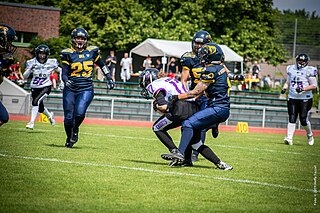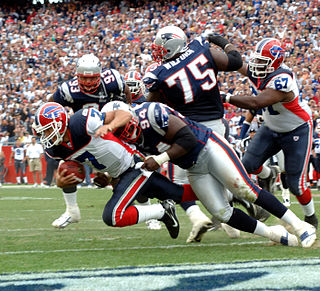In gridiron football, not all players on offense are entitled to receive a forward pass: only an eligible pass receiver may legally catch a forward pass, and only an eligible receiver may advance beyond the neutral zone if a forward pass crosses into the neutral zone. If the pass is received by a non-eligible receiver, it is "illegal touching". If an ineligible receiver is beyond the neutral zone when a forward pass crossing the neutral zone is thrown, a foul of "ineligible receiver downfield" is called. Each league has slightly different rules regarding who is considered an eligible receiver.

The quarterback, colloquially known as the "signal caller", is a position in gridiron football. Quarterbacks are members of the offensive platoon and mostly line up directly behind the offensive line. In modern American football, the quarterback is usually considered the leader of the offense, and is often responsible for calling the play in the huddle. The quarterback also touches the ball on almost every offensive play, and is almost always the offensive player that throws forward passes. When the QB is tackled behind the line of scrimmage, it is called a sack.
Super Bowl V was an American football game played between the American Football Conference (AFC) champion Baltimore Colts and the National Football Conference (NFC) champion Dallas Cowboys to determine the National Football League (NFL) champion for the 1970 season. It was the fifth edition of the Super Bowl and the first modern-era NFL championship game. The Colts defeated the Cowboys by the score of 16–13 on a field goal with 5 seconds left in the game. The game was played on January 17, 1971, at the Orange Bowl in Miami, Florida, the first Super Bowl game played on artificial turf, on first-generation Poly-Turf.

A fumble in gridiron football occurs when a player who has possession and control of the ball loses it before being downed (tackled), scoring, or going out of bounds. By rule, it is any act other than passing, kicking, punting, or successful handing that results in loss of ball possession by a player.

In gridiron football, a sack occurs when the quarterback is tackled behind the line of scrimmage before throwing a forward pass, when the quarterback is tackled behind the line of scrimmage in the "pocket" and without clear intent, or when a passer runs out of bounds behind the line of scrimmage due to defensive pressure. This often occurs if the opposing team's defensive line, linebackers or defensive backs are able to apply pass pressure to quickly get past blocking players of the offensive team, or if the quarterback is unable to find a back to hand the ball off to or an available eligible receiver to catch the ball, allowing the defense a longer opportunity to tackle the quarterback.

Gridiron football, also known as North American football, or in North America as simply football, is a family of football team sports primarily played in the United States and Canada. American football, which uses 11 players, is the form played in the United States and the best known form of gridiron football worldwide, while Canadian football, which uses 12 players, predominates in Canada. Other derivative varieties include arena football, flag football and amateur games such as touch and street football. Football is played at professional, collegiate, high school, semi-professional, and amateur levels.

American and Canadian football are gridiron codes of football that are very similar; both have their origins partly in rugby football, but some key differences exist between the two codes.

Gameplay in American football consists of a series of downs, individual plays of short duration, outside of which the ball is dead or not in play. These can be plays from scrimmage – passes, runs, punts or field goal attempts – or free kicks such as kickoffs and fair catch kicks. Substitutions can be made between downs, which allows for a great deal of specialization as coaches choose the players best suited for each particular situation. During a play, each team should have no more than 11 players on the field, and each of them has specific tasks assigned for that specific play.

An option offense is an American football offensive system in which a key player has several "options" of how each play will proceed based upon the actions of the defense. Traditionally, option-based offenses rely on running plays, though most mix in forward passes from an option formation as a change of pace. A successful option-based offense can keep possession of the ball for long periods of time, giving the opposing offense fewer possessions and keeping the option team's defense rested. However, because passing is often not a strength of the system, it can be difficult for option-based offenses to come back from a large deficit or to score quickly when needed.

A kickoff is a method of starting a drive in gridiron football. Additionally, it may refer to a kickoff time, the scheduled time of the first kickoff of a game. Typically, a kickoff consists of one team – the "kicking team" – kicking the ball to the opposing team – the "receiving team". The receiving team is then entitled to return the ball, i.e., attempt to advance it towards the kicking team's end zone, until the player with the ball is tackled by the kicking team, goes out of bounds, scores a touchdown, or the play is otherwise ruled dead. Kickoffs take place at the start of each half of play, the beginning of overtime in some overtime formats, and after scoring plays.

In American football and Canadian football, a quarterback kneel, also called taking a knee, genuflect offense, kneel-down offense, or victory formation, occurs when the quarterback touches a knee to the ground immediately after receiving the snap, thus downing himself and ending the play. It is primarily used to run the clock down, either at the end of the first half or the game itself, to preserve a lead or ensure a game goes into overtime if the game is tied and it's the fourth quarter. Although it generally results in a loss of some yardage and uses up a down, it minimizes the risk of a fumble, which would give the other team a chance at recovering the ball.

In gridiron football, the safety or safety touch is a scoring play that results in two points being awarded to the scoring team. Safeties can be scored in a number of ways, such as when a ball carrier is tackled in his own end zone or when a foul is committed by the offense in its own end zone. After a safety is scored in American football, the ball is kicked off to the team that scored the safety from the 20-yard line; in Canadian football, the scoring team also has the options of taking control of the ball at its own 35-yard line or kicking off the ball, also at its own 35-yard line. The ability of the scoring team to receive the ball through a kickoff differs from the touchdown and field goal, which require the scoring team to kick the ball off to the scored-upon team. Despite being of relatively low point value, safeties can have a significant impact on the result of games, and Brian Burke of Advanced NFL Stats estimated that safeties have a greater abstract value than field goals, despite being worth a point less, due to the field position and reclaimed possession gained off the safety kick.
A comparison between American football and rugby league is possible because of their shared origins and similar game concepts. Rugby league is arguably the most similar sport to American football after Canadian football: both sports involve the concept of a limited number of downs/tackles and scoring touchdowns/tries takes clear precedence over goal-kicking.
In gridiron football, intentional grounding is a violation of the rules where "a passer...throws a forward pass without a realistic chance of completion." This typically happens when a quarterback about to be sacked passes the ball toward an area of the field with no eligible receiver. Without this rule, the quarterback could almost always avoid a sack by intentionally throwing an incomplete pass ; instead, the penalty of intentional grounding effectively continues play as if the defense had succeeded in sacking the quarterback.
The following terms are used in American football, both conventional and indoor. Some of these terms are also in use in Canadian football; for a list of terms unique to that code, see Glossary of Canadian football.

American football, also known as gridiron football, is a team sport played by two teams of eleven players on a rectangular field with goalposts at each end. The offense, the team with possession of the oval-shaped football, attempts to advance down the field by running with the ball or passing it, while the defense, the team without possession of the ball, aims to stop the offense's advance and to take control of the ball for themselves. The offense must advance at least ten yards in four downs or plays; if they fail, they turn over the football to the defense, but if they succeed, they are given a new set of four downs to continue the drive. Points are scored primarily by advancing the ball into the opposing team's end zone for a touchdown or kicking the ball through the opponent's goalposts for a field goal. The team with the most points at the end of a game wins.

In gridiron football, a penalty is a sanction assessed against a team for a violation of the rules, called a foul. Officials initially signal penalties by tossing a bright yellow colored penalty flag onto the field toward or at the spot of a foul.

Offside is a minor foul in gridiron football caused when a player crosses the line of scrimmage ahead of the snap of the ball. The penalty associated with the infraction is the advancing of the ball five yards and a replay of the down.

In gridiron football, a punt is a kick performed by dropping the ball from the hands and then kicking the ball before it hits the ground. The most common use of this tactic is to punt the ball downfield to the opposing team, usually on the final down, with the hope of giving the receiving team a field position that is more advantageous to the kicking team when possession changes. The result of a typical punt, barring any penalties or extraordinary circumstances, is a first down for the receiving team. A punt is not to be confused with a drop kick, a kick after the ball hits the ground, now rare in both American and Canadian football.














